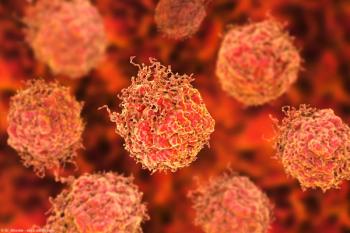
Glypican-1 shows promise as prostate cancer biomarker
The cell surface amino acid glypican-1 (GPC-1) represents a potential new biomarker for prostate cancer, said Jonathan Henderson, MD, at the AUA annual meeting.
New Orleans-The cell surface amino acid glypican-1 (GPC-1) represents a potential new biomarker for
A pilot study conducted in 345 men older than 50 years found high specificity of GPC-1 for prostate cancer. Its likely clinical use will be as an adjunctive test to patients with an elevated level of PSA, said Dr. Henderson, a urologist at Regional Urology in Shreveport, LA.
“The take-home message we found with this test is that the clinical utility is a high specificity,” he said. “We think we can use the PSA result for the sensitivity that it gives us but then fine tune it with GPC-1, with the specificity demonstrated at 79% for prostate cancer patients.”
GPC-1 is a 558 amino acid-linked proteoglycan that occurs on the cell wall of prostate tissue. It functions as a co-receptor that regulates growth factor signaling.
In preclinical studies, a monoclonal antibody was developed-MIL-38-that binds GPC-1. Immunohistochemical staining showed no binding to normal prostate but did stain the majority of prostate cancers. A proof-of-concept study using urine samples showed a sensitivity of 71% and a specificity of 73% in discriminating between prostate cancer and normal tissues.
An ELISA kit (MiCheck) was developed, which detects GPC-1 in serum, plasma, and urine. Assay linearity was demonstrated over a working concentration of 10 pg/mL to 1.5 ng/mL. The calculated limit of detection was 3.4 pg/mL with a limit of quantitation at 7.2 pg/mL.
The purpose of the pilot study was to have a multicenter, retrospective non-randomized study to validate the future regulatory claims of the MiCheck technology. The objectives were to investigate the range of GPC-1 in normal tissue, benign tissue, and malignant tissue.
For this, the study included three arms with 115 subjects in each arm. Arm 1, the healthy arm with a normal digital rectal examination, included men older than 50 years with PSA <2.0 ng/mL (<3.0 ng/mL for men 60 years and older). Men with pathologically confirmed BPH or clinical BPH if PSA was in the normal range were enrolled in arm 2. Arm 3 constituted men with prostate cancer who were at least 1 week post-biopsy and had a Gleason score ≥7 to include only significant cancer.
“Further, we wanted to test the ability of the ELISA both alone and in combination with other biomarkers to improve the differentiation between non-cancers and cancerous prostate tissue compared with PSA alone,” said Dr. Henderson.
The study was led by Neal Shore, MD, medical director of Carolina Urologic Research Center, Myrtle Beach, SC, and was run by the CUSP research consortium across 10 tertiary community sites in the United States. The sponsor was Minomic International Ltd., of Sydney, Australia.
More from AUA 2015 :
Very good correlation was found between both plasma and serum results for GPC-1, with circulating GPC-1 declining in prostate cancer, thereby significantly differentiating between normal and benign tissue compared with prostate cancer (p=.035 for plasma and p=.034 for serum).
Various GPC-1 cut points were assessed to maximize clinical utility (high specificity). Specificity was maximized at the cut points of 1.85 log in plasma and 1.95 log in serum to permit the test’s use as an adjunctive test to PSA to allow a better outcome for specificity. The specificity was 79% in plasma and 75% in serum for prostate cancer, with sensitivity of 32% and 37%, respectively. For prostate cancer patients with PSA of 4.0 to 10.0 ng/mL, specificity was 79% and sensitivity was 33%.
“GPC-1 shows significant promise in improving specificity, comparing prostate cancer to benign tissues,” Dr. Henderson said. “The likely clinical use of this molecule will be as an adjunctive test in patients who have an elevated PSA, specifically in that gray zone between 4.0 and 10.0 ng/mL.”
The next steps “are to engage the Early Detection Research Network, specifically validating those patients with PSA between 4.0 and 10.0 ng/mL, and then moving onto a pivotal trial of 1,200 patients, again using the CUSP consortium,” he said.
More on Prostate Cancer
To get weekly news from the leading news source for urologists,
Newsletter
Stay current with the latest urology news and practice-changing insights — sign up now for the essential updates every urologist needs.


















